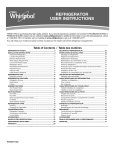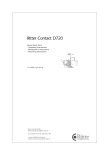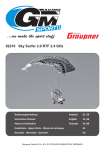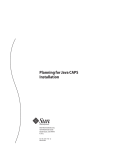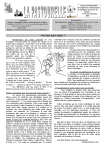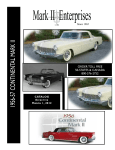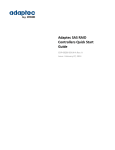Download SERVICE MANUAL
Transcript
INTRODUCTION PRECAUTION GENERAL REPAIR INSTRUCTIONS..................................... IN- 1 PRECAUTIONS FOR REPAIRING BODY STRUCTURE PANELS .................................................... IN- 2 PROPER AND EFFICIENT WORK PROCEDURES .............. IN- 4 HANDLING PRECAUTIONS ON RELATED COMPONENTS IN- 9 DAMAGED VEHICLE DISPOSAL PRECAUTION (SRS AIRBAG SYSTEM) ................................................. IN- 10 HANDLING PRECAUTIONS ON RELATED COMPONENTS IN- 11 ABOUT THIS VEHICLE STRUCTUAL OUTLINE ......................................................... IN- 14 NOTICE ABOUT VEHICLE CONDITION WHEN JACKING UP VEHICLE 1. NOTICE FOR USING JACK AND SAFETY STAND .......... IN- 15 2. NOTICE FOR USING SWING ARM TYPE LIFT................. IN- 16 3. NOTICE FOR USING PLATE TYPE LIFT........................... IN- 16 DAMAGE DIAGNOSIS .................................................... IN- 17 COMPONENTS 1. FRONT BUMPER................................................................ IN- 20 2. REAR BUMPER .................................................................. IN- 21 3. INSTRUMENT PANEL ........................................................ IN- 22 4. INTERIOR TRIM.................................................................. IN- 24 5. FRONT SEAT ...................................................................... IN- 27 6. REAR SEAT ........................................................................ IN- 28 WHEEL ALIGNMENT STANDARD 1. FRONT WHEEL ALIGNMENT ............................................ IN- 30 HOW TO USE THIS MANUAL 1. BODY PANEL REPLACEMENT THIS MANUAL ............... IN- 32 2. SYMBOLS ........................................................................... IN- 34 3. ILLUSTRATION OF WELD POINT SYMBOLS .................. IN- 36 ABBREVIATIONS USED IN THIS MANUAL.......................... IN- 37 NOTE: This manual has references to the Daihatsu TERIOS Service Manual’s heater & air conditioning system, body electrical and suspension & axle sections. INTRODUCTION IN-1 PRECAUTION GENERAL REPAIR INSTRUCTIONS 1. WORK PRECAUTIONS (a) VEHICLE PROTECTION (1) When welding, protect the painted surfaces, windows, seats and carpet with heat resistant, fireproof covers. Glass Cover Seat Cover F33000 (b) SAFETY (1) Never stand in a direct line with the chain when using a puller on the body or frame, and be sure to attach a safety cable. WRONG F33001 (2) Before performing repair work, check for fuel leaks. If a leak is found, be sure to close the opening completely. (3) If it is necessary to use a flame in the area of the fuel tank, first remove the tank and plug the fuel line. WRONG F33002 (c) SAFETY WORK CLOTHES (1) In addition to the usual mechanic’s wear, cap and safety shoes, the appropriate gloves, head protector, glasses, ear plugs, face protector, dust-prevention mask, etc. should be worn as the situation demands. F33003 Code Name A Dust-Prevention Mask B Face Protector C Eye Protector D Safety Shoes E Welder’s Glasses F Ear Plugs G Head Protector H Welder’s Gloves BRM RUSH D99B BM05F0ED INTRODUCTION IN-2 PRECAUTIONS FOR REPAIRING BODY STRUCTURE PANELS 1. Toyota prohibits the use of the heat repair method on body structure panels when repairing a vehicle damaged in a collision. Panels that have high strength and rigidity, as well as a long life span for the automobile body are in high demand. At Toyota, in order to fulfill these requirements, we use high tensile strength steel sheets and rust preventive steel sheets on the body. High tensile steel sheets are made with alloy additives and a special heat treatment in order to improve their strength. To prevent the occurrence of rust for a long period of time, the surface of the steel is coated with a zinc alloy. If body structure parts are heat repaired with an acetylene torch or other heating source, the crystalline organization of the steel sheet will change and their strength of the steel sheet will be reduced. The ability of the body to resist rust is significantly lowered as well since the rust resistant zinc coating is destroyed by heat and the steel sheet surface is oxidized. F33014 2. F33015 HEAT REPAIR FOR BODY STRUCTURE PANELS STRUCTURE PANEL KINKS A sharp deformation angle on a panel that cannot be returned to its original shape by pulling or hammering is called a kink. Structural parts are designed to perform in their original shape. If parts are deformed in an accident, or if the deformed parts are repaired and reused, the parts may be unable to perform as intended. It is necessary to replace the part where the kink has occurred. BRM RUSH D99B BM05F0ED INTRODUCTION 3. F33016 IN-3 IMPACT BEAM AND BUMPER REINFORCEMENT REPAIR The impact beam and bracket are necessary and important parts that help reduce the probability of injury to passengers in side collisions. For impact beams, we use special high tensile strength steel. The high tensile strength steel maintains its special crystalline organization by heat treatment or alloy additives. Structural parts are designed to perform in their original shape. If parts are deformed in an accident, or if the deformed parts are repaired and reused, the parts may be unable to perform as intended. If the impact beam or bracket is damaged, replace the door assembly that has the damaged beam. Also, the bumper reinforcement is a necessary and important part that helps reduce the probability of injury to passengers in front collisions, and for the same reasons explained above, should be replaced if damaged. F33017 F30442 BRM RUSH D99B BM05F0ED INTRODUCTION IN-4 PROPER AND EFFICIENT WORK PROCEDURES 1. Body Measument Diagrams REMOVAL (a) PRE-REMOVAL MEASURING (1) Before removal or cutting operations, take measurements in accordance with the dimensions diagram. Always use a puller to straighten a damaged body or frame. F33020 (b) CUTTING AREA (1) Always cut in a straight line and avoid cutting reinforced areas. Cutting Okay Corners Reinforcement F33021 (c) PRECAUTIONS FOR DRILLING OR CUTTING (1) Check behind any area to be drilled or cut to ensure that there are no hoses, wires, etc., that may be damaged. HINT: See “Handling Precautions on Related Components” on page IN-9. WRONG F33022 (d) REMOVAL OF ADJACENT COMPONENTS (1) When removing adjacent components, apply protective tape to the surrounding body and your tools to prevent damage. HINT: See “Handling Precautions on Related Components” on page IN-9. F33007 BRM RUSH D99B BM05F0ED INTRODUCTION 2. IN-5 PREPARATION FOR INSTALLATION (a) SPOT WELD POINTS (1) When welding panels with a combined thickness of over 3 mm (0.12 in.), use a MIG (Metal Inert Gas) welder for plug welding. HINT: Spot welding does not provide sufficient durability for panels with a combined thickness of over 3 mm (0.12 in.). Less than 3 mm F10011A (b) APPLICATION OF WELD-THROUGH PRIMER (SPOT SEALER) (1) Remove the paint from the portion of the new parts and body to be welded, and apply weld-through primer. F33008 (c) MAKING HOLES FOR PLUG WELDING (1) For areas where a spot welder cannot be used, use a puncher or drill to make holes for plug welding. REFERENCE: mm (in.) Puncher F33009 Thickness of welded portion Size of plug hole 1.0 (0.04) under ø 5 (0.20) over 1.0 (0.04) − 1.6 (0.06) ø 6.5 (0.26) over 1.7 (0.07) − 2.3 (0.09) ø 8 (0.31) over 2.4 (0.09) over ø 10 (0.39) over (d) SAFETY PRECAUTIONS FOR ELECTRICAL COMPONENTS (1) When welding, there is a danger that electrical components will be damaged by the electrical current flowing through the body. (2) Before starting work, disconnect the negative terminal of the battery and ground the welder near the welding location of the body. F33023 Air Saw 20 − 30 mm Overlap (e) ROUGH CUTTING OF JOINTS (1) For joint areas, rough cut the new parts, leaving 20 − 30 mm (0.79 − 1.18 in.) of overlap. F33024 BRM RUSH D99B BM05F0ED INTRODUCTION IN-6 3. INSTALLATION (a) PRE-WELDING MEASUREMENTS (1) Always take measurements before installing underbody or engine components to ensure correct assembly. After installation, confirm proper fit. F33025 (b) WELDING PRECAUTIONS (1) The number of welding spots should be as follows. Spot weld: 1.3 X No. of manufacturer’s spots. Plug weld: More than No. of manufacturer’s plugs. (2) Plug welding should be done with a MIG (Metal Inert Gas) welder. Do not gas weld or braze panels at areas other than where specified. WRONG F10017A (c) POST-WELDING REFINISHING (1) Always check the welded spots to ensure that they are secure. (2) When smoothing out the weld spots with a disc grinder, be careful not to grind off too much as this will weaken the weld. CORRECT WRONG F10018A (d) SPOT WELD LOCATIONS (1) Avoid welding over previously welded areas. Old Spot Locations New Spot Locations F33010 Tip Cutter F10019A (e) SPOT WELDING PRECAUTIONS (1) The shape of the tip point of the spot welder significantly affects the strength of the weld. Therefore, maintain the tip point in the proper shape, and allow it to cool after every five or six spots. (2) Completely remove the paint from the areas to be spot welded, including the seams and the surfaces that come in contact with the welding tip. (3) Use a sander to remove any burrs that are created during spot welding. BRM RUSH D99B BM05F0ED INTRODUCTION 4. Sealer Gun IN-7 ANTI-RUST TREATMENT AFTER INSTALLATION (BEFORE PAINTING PROCESS) (a) BODY SEALER APPLICATION (1) For water-proofing and anti-corrosion measures, always apply the body sealer to the body panel seams and hems of the doors, hood, etc. F33011 (b) UNDERCOAT APPLICATION (1) To prevent corrosion and protect the body from damage by flying stones, always apply sufficient under coating to the bottom surface of the under body and inside of the wheel housings. F33012 5. ANTI-RUST TREATMENT AFTER INSTALLATION (AFTER PAINTING PROCESS) (a) ANTI-RUST AGENT (WAX) APPLICATION (1) To preserve impossible to paint areas from corrosion, always apply sufficient anti-rust agent (wax) to the inside of the hemming areas of the doors and hood, and around the hinges, or the welded surfaces inside the box-shaped cross sections of the side members, body pillars, etc. F33013 BRM RUSH D99B BM05F0ED INTRODUCTION IN-8 6. ANTI-RUST TREATMENT BY PAINTING REFERENCE: Painting prevents corrosion and protects the sheet metal from damage. In this section, anti-chipping paint only for anti-corrosion purposes is described. (a) ANTI-CHIPPING PAINT (1) To prevent corrosion and protect the body from damage by flying stones, etc., apply anti-chipping paint to the rocker panel, wheel arch areas, balance panel, etc. HINT: Depending on the model or the application area, there are cases where the application of anti-chipping paint is necessary before the second coat or after the top coat. S Apply the anti-chipping paint after the top coat. S Apply the anti-chipping paint before the second coat. Anti-Chipping Paint Top Coat Second Coat Top Coat Second Coat Anti-Chipping Paint Under Coat (ED Primer) Under Coat (ED Primer) Steel Metal Steel Metal F10024A BRM RUSH D99B BM05F0ED INTRODUCTION IN-9 HANDLING PRECAUTIONS ON RELATED COMPONENTS 1. BRAKE SYSTEM The brake system is one of the most important safety components. Always follow the directions and notes given in the brake section of the repair manual for the relevant model year when handling brake system parts. NOTICE: When repairing the brake master cylinder or ABS and TRAC system, bleed the air out of the ABS and TRAC system. 2. DRIVE TRAIN AND CHASSIS The drive train and chassis are components that can have great effects on the running performance and vibration resistance of the vehicle. After installing components in the sections listed in the table below, perform alignments to ensure correct mounting angles and dimensions. Body repair must be particularly accurate to ensure correct alignment. HINT: Correct procedures and special tools are required for alignment. Always follow the directions given in the repair manual for the relevant model year during alignment and in section DI of this section. 3. Component to be aligned Section of repair manual for relevant model Front Wheels Front Suspension section Rear Wheels Rear Suspension section Propeller Shaft Propeller Shaft section COMPONENTS ADJACENT TO THE BODY PANELS Various types of component parts are mounted directly on or adjacent to the body panels. Strictly observe the following precautions to prevent damaging these components and the body panels during handling. S Before repairing the body panels, remove their components or apply protective covers over the components. S Before prying components off using a screwdriver or a scraper, etc., attach protective tape to the tool tip or blade to prevent damaging the components and the body paint. S Before removing components from the outer surface of the body, attach protective tape to the body to ensure no damage to painted areas. HINT: Apply touch-up paint to any damaged paint surfaces. S Before drilling or cutting sections, make sure that there are no wires, etc., on the reverse side. 4. ECU (ELECTRONIC CONTROL UNIT) Many ECUs are mounted in this vehicle. Take the following precautions during body repair to prevent damage to the ECUs. S Before starting electric welding operations, disconnect the negative (−) terminal cable from the battery. When the negative (−) terminal cable is disconnected from the battery, the memory of the clock and audio systems will be erased. Before starting work, make a record of the contents memorized by each memory system. Then when work is finished, reset the clock and audio systems as before. When the vehicle has tilt and telescopic steering, power seats and outside rear view mirrors, which are all equipped with a memory function, it is not possible to make a record of the memory contents. When the operation is finished, it will be necessary to explain this fact to the customer, and request the customer to adjust the features and reset the memory. S Do not expose the ECUs to ambient temperatures above 80_C (176_F). NOTICE: If it is possible that the ambient temperature may reach 80_C (176_F) or more, remove the ECUs from the vehicle before starting work. S Be careful not to drop the ECUs and not to apply physical shocks to them. BRM RUSH D99B BM05F0ED INTRODUCTION IN-10 DAMAGED VEHICLE DISPOSAL PRECAUTION (SRS AIRBAG SYSTEM) For SRS airbag system adjustment service and repair procedures, refer to the Repair Manual. (1) When using an electric welder, first remove all airbags and seat belt pretensioners. (2) If impacts are likely to occur to the front airbag sensors or center airbag sensor remove each sensor as necessary beforehand. (3) Do not allow the front airbag sensors or center airbag sensor to become heated to high temperatures. COMBINATION METER SRS WARNING LIGHT FRONT AIRBAG SENSOR RH SPIRAL CABLE STEERING PAD FRONT PASSENGER AIRBAG ASSEMBLY CENTER AIRBAG SENSOR ASSEMBLY C156068 BRM RUSH D99B BM05F0ED INTRODUCTION IN-11 HANDLING PRECAUTIONS OF PLASTIC BODY PARTS 1. 2. 3. The repair procedure for plastic body parts must conform with the type of plastic material. Plastic body parts are identified by the codes in the following table. When repairing metal body parts adjoining plastic body parts (by brazing, frame cutting, welding, painting etc.), consideration must be given to the properties of the plastic. Code Material name Heat* resistant temperature limit _C (_F) Resistance to alcohol or gasoline Notes AAS Acrylonitrile Acrylic Styrene 80 (176) Alcohol is harmless if applied only for short time in small amounts (e.g., quick wiping to remove grease). Avoid gasoline and organic or aromatic solvents. ABS Acrylonitrile Butadiene Styrene 80 (176) Alcohol is harmless if applied only for short time in small amounts (e.g., quick wiping to remove grease). Avoid gasoline and organic or aromatic solvents. AES Acrylonitrile Ethylene Styrene 80 (176) Alcohol is harmless if applied only for short time in small amounts (e.g., quick wiping to remove grease). Avoid gasoline and organic or aromatic solvents. ASA Acrylonitrile Styrene Acrylate 80 (176) Alcohol is harmless if applied only for short time in small amounts (e.g., quick wiping to remove grease). Avoid gasoline and organic or aromatic solvents. EPDM Ethylene Propylene 100 (212) Alcohol is harmless. Gasoline is harmless if applied only for short time in small amounts. Most solvents are harmless but avoid dipping in gasoline, solvents, etc. PA Polyamide (Nylon) 80 (176) Alcohol and gasoline are harmless. Avoid battery acid. PBT Polybutylene Terephthalate 160 (320) Alcohol and gasoline are harmless. Most solvents are harmless. PC Polycarbonate 120 (248) Alcohol is harmless. Avoid gasoline, brake fluid, wax, wax removers and organic solvents. Avoid alkali. Polymethyl Methacrylate 80 (176) Alcohol is harmless if applied only for short time in small amounts. Avoid dipping or immersing in alcohol, gasoline, solvents, etc. Polyoxymethylene (Polyacetal) 100 (212) Alcohol and gasoline are harmless. Most solvents are harmless. Polypropylene 80 (176) Alcohol and gasoline are harmless. Most solvents are harmless. PVC Polyvinylchloride (Vinyl) 80 (176) Alcohol and gasoline are harmless if applied only for short time in small amounts (e.g., quick wiping to remove grease). Avoid dipping or immersing in alcohol, gasoline, solvents, etc. TPO Thermoplastic Olefine 80 (176) Alcohol is harmless. Gasoline is harmless if applied only for short time in small amounts. Most solvents are harmless but avoid dipping in gasoline, solvents, etc. PMMA POM PP *Temperatures higher than those listed here may result in material deformation during repair. BRM RUSH D99B BM05F0ED INTRODUCTION IN- 12 Outer Rear View Light Mirror (ABS/AAS/PBT) Roof Drip Side Finish Moulding (PVC) Cowl Top Ventilator Louver (PP) Rear Door Guide Bracket Garnish (ASA) Radiator Grille (ABS) Headlight (PC/PP) Side Step End Cap (PE) Front Door Outside Handle (PA/PC/PBT) Emblem (ABS) Rear Door Outside Handle (PA/PC/PBT) Side Step End Cap (PE) Side Turn Signel Light (PMMA/PC/PBT) Front Bumper Cover (PP) / Made up of 2 or more kinds of materials. F30394 BRM RUSH D99B BM05F0ED INTRODUCTION IN-13 97 Roof Rack Leg Cover (ABS) Roof Rack Leg Cover (ABS) Back Door Outside Handle (PC/PBT) Rear Bumper Cover (PP) License Plate Light (PC/PBT) Spare Wheel Cover (AES) Reflex Refrector (PMMA/ABS) Rear Combination Light (PMMA/ASA) / Made up of 2 or more kinds of materials. F30395 BRM RUSH D99B BM05F0ED INTRODUCTION IN- 14 ABOUT THIS VEHICLE STRUCTURAL OUTLINE . . . 340 Mpa High strength steel . . . 440 Mpa High strength steel . . . Formed material application areas (refer to PC-8) F30388 BRM RUSH D99B BM05F0ED INTRODUCTION IN-15 NOTICE ABOUT VEHICLE CONDITION WHEN JACKING UP VEHICLE 1. NOTICE FOR USING JACK AND SAFETY STAND : JACK POSITION Jack Point : SUPPORT POSITION, PANTOGRAPH JACK POSITION D10170 BRM RUSH D99B BM05F0ED INTRODUCTION IN- 16 2. NOTICE FOR USING SWING ARM TYPE LIFT : CENTER OF VEHICLE GRAVITY (unloaded condition) Center of Lift D101716 3. NOTICE FOR USING PLATE TYPE LIFT Attachment Dimensions 85 mm (3.35 in.) 70 mm (2.76 in.) 100 mm (3.94 in.) 200 mm (7.87 in.) Attachment HINT: Right and left set position Place the vehicle over the center of the lift. HINT: Front and left set position Place the attachments at the ends of the rubber plate surface, under the vehicle lift pad (A and C in the illustration). Raise the plate slightly and reposition the vehicle so the top of the attachment (B in the illustration) is aligned with the front side notch in the vehicle rocker flange. D101771 BRM RUSH D99B BM05F0ED INTRODUCTION IN-17 DAMAGE DIAGNOSIS Front Bumper Reinforcement Front Side Member Rear Floor Side Member Front Side Member Inner Front Body Pillar Inner Apron Upper Member Front Side Member Rear Floor Side Member : Confirmation Point : Collision Direction : Collision Force Absorption Direction D30389 BRM RUSH D99B BM05F0ED INTRODUCTION IN- 18 Rear Floor Side Member Rear Floor Side Member Rear Bumper Reinforcement : Confirmation Point : Collision Direction : Collision Force Absorption Direction F30390 BRM RUSH D99B BM05F0ED INTRODUCTION IN-19 Center Floor Crossmember Front Door Outer Panel Side Reinforcement : Confirmation Point : Collision Direction : Collision Force Absorption Direction F30391 BRM RUSH D99B BM05F0ED INTRODUCTION IN-20 COMPONENTS 1. FRONT BUMPER FRONT FENDER LINER RH FRONT BUMPER SIDE SUPPORT RH FRONT BUMPER COVER FRONT FENDER LINER LH FOG LIGHT COVER RH 6.0 (61, 53 in..lbf) FOG LIGHT COVER LH FRONT BUMPER HOLE COVER FRONT BUMPER SIDE SUPPORT LH with Fog Light: FOG LIGHT ASSEMBLY RH FOG LIGHT ASSEMBLY LH CAUTION: The bolts and nuts must be tightened to the torque specification, as they are related to vehicle safety during a collision. N.m (kgf.cm, ft..lbf) : Specified torque F30449 BRM RUSH D99B BM05F0ED INTRODUCTION 2. IN-21 REAR BUMPER 13.5 (137, 9.9) 13.5 (137, 9.9) REAR BUMPER SIDE SUPPORT RH REAR BUMPER SIDE SUPPORT LH REAR WHEEL HOUSE LINER LH REAR WHEEL HOUSE LINER RH QUARTER PANEL MUDGUARD REAR LH REAR BUMPER COVER QUARTER PANEL MUDGUARD REAR RH 6.0 (61, 53 in..lbf) REAR BUMPER UPPER COVER RH 6.0 (61, 53 in..lbf) REFLEX REFLECTOR ASSEMBLY LH LICENSE PLATE LIGHT ASSEMBLY REFLEX REFLECTOR ASSEMBLY RH CAUTION: The bolts and nuts must be tightened to the torque specification, as they are related to vehicle safety during a collision. N.m (kgf.cm, ft..lbf) : Specified torque F30451 BRM RUSH D99B BM05F0ED INTRODUCTION IN-22 3. INSTRUMENT PANEL NO. 1 INSTRUMENT PANEL CUSHION NO. 1 DEFROSTER NOZZLE GARNISH NO. 2 DEFROSTER NOZZLE GARNISH NO. 2 INSTRUMENT PANEL CUSHION CENTER HEATER TO REGISTER DUCT SUB-ASSEMBLY FRONT PASSENGER AIR BAG ASSEMBLY 8.2 (84, 73 in..lbf) INSTRUMENT PANEL SUB-ASSEMBLY FRONT PILLAR GARNISH GLOVE COMPARTMENET DOOR LOCK STRIKER NO. 1 INSTRUMENT PANEL REGISTER ASSEMBLY NO. 1 SWITCH HOLE BASE NO. 2 INSTRUMENT PANEL REGISTER ASSEMBLY COMBINATION METER ASSEMBLY NO. 1 INSTRUMENT PANEL BRACE SUB-ASSEMBLY WINDSHIELD WIPER SWITCH ASSEMBLY STEERING COLUMN UPPER COVER STEERING WHEEL SUB-ASSEMBLY INSTRUMENT CLUSTER FINISH PANEL NO. 2 STEERING WHEEL LOWER COVER HEADLIGHT DIMMER SWITCH ASSEMBLY 34 (347, 25) STEERING COLUMN LOWER COVER NO. 3 STEERING WHEEL LOWER COVER 8.8 (90, 78 in..lbf) STEERING PAD CAUTION: The bolts and nuts must be tightened to the torque specification, as they are related to vehicle safety during a collision. N.m (kgf.cm, ft..lbf) : Specified torque F30452 BRM RUSH D99B BM05F0ED INTRODUCTION NO. 1 INSTRUMENT CLUSTER FINISH PANEL GARNISH IN-23 CENTER INSTRUMENT CLUSTER FINISH PANEL SUB-ASSEMBLY CARD HOLDER STEREO COMPONENT TUNER ASSEMBLY NO. 2 INSTRUMENT PANEL UNDER COVER for Automatic Transmission: SHIFT LEVER KNOB SUB-ASSEMBLY CONSOLE BOX NO. 1 INSTRUMENT PANEL UNDER COVER SUB-ASSEMBLY for Manual Transmission: SHIFT LEVER KNOB SUB-ASSEMBLY SHIFTING HOLE COVER COIN BOX ASSEMBLY GLOVE COMPARTMENT DOOR ASSEMBLY SIDE COWL TRIM BOARD SHIFTING HOLE BEZEL SHIFTING HOLE PLATE FRONT DOOR SCUFF PLATE CONSOLE BOX HOLE COVER REAR INNER ASH RECEP TACLE RETAINER REAR UPPER CONSOLE BOX NO. 1 CONSOLE BOX MOUNTING BRACKET REAR NO. 1 ASH RECEPTACLE RETAINER ASH RECEPTACLE BOX SUB-ASSEMBLY F30453 BRM RUSH D99B BM05F0ED INTRODUCTION IN- 24 4. INTERIOR TRIM FRONT SHOULDER BELT ANCHOR ADJUSTER ASSEMBLY 41 (418, 30) SHOULDER BELT ANCHOR COVER UPPER CENTER PILLAR GARNISH RH REAR DOOR OPENING TRIM RH FRONT DOOR OPENING TRIM RH 41 (418, 30) FRONT OUTER SEAT BELT ASSEMBLY RH 41 (418, 30) LOWER CENTER PILLAR GARNISH RH REAR DOOR SCUFF PLATE RH FRONT DOOR SCUFF PLATE RH 41 (418, 30) CAUTION: The bolts and nuts must be tightened to the torque specification, as they are related to vehicle safety during a collision. N.m (kgf.cm, ft..lbf) : Specified torque F30454 BRM RUSH D99B BM05F0ED INTRODUCTION IN-25 ROOF SIDE INNER GARNISH RH SEAT BELT ANCHOR COVER 41 (418, 30) SHOULDER BELT ANCHOR COVER 41 (418, 30) REAR DOOR OPENING TRIM RH 41 (418, 30) REAR OUTER NO. 1 SEAT BELT ASSEMBLY RH DECK TRIM SIDE PANEL ASSEMBLY RH REAR DOOR SCUFF PLATE RH CAUTION: The bolts and nuts must be tightened to the torque specification, as they are related to vehicle safety during a collision. N.m (kgf.cm, ft..lbf) : Specified torque F30455 BRM RUSH D99B BM05F0ED INTRODUCTION IN- 26 ROOF HEADLINING ASSEMBLY ASSIST GRIP SUBASSEMBLY WASHER HOSE NO. 1 ROOF WIRE MAP LIGHT ASSEMBLY VISOR ASSEMBLY RH INNER REAR VIEW MIRROR STAY HOLDER COVER VISOR HOLDER NO. 1 ROOM LIGHT ASSEMBLY VISOR ASSEMBLY LH INNER REAR VIEW MIRROR ASSEMBLY BACK DOOR WEATHERSTRIP with Air conditioning System: AIR INLET DUCT AIR OUTLET DUCT BACK DOOR SCUFF PLATE F30456 BRM RUSH D99B BM05F0ED INTRODUCTION 5. IN-27 FRONT SEAT CAP FRONT SEAT ASSEMBLY RH SEAT TRACK COVER RH FRONT INNER SEATBELT ASSEMBLY RH 25 (255, 18) 41 (418, 30) FRONT INNER SEAT CUSHION SHIELD RH CAUTION: The bolts and nuts must be tightened to the torque specification, as they are related to vehicle safety during a collision. N.m (kgf.cm, ft..lbf) : Specified torque B164666 BRM RUSH D99B BM05F0ED INTRODUCTION IN- 28 6. REAR SEAT REAR NO. 1 SEAT ASSEMBLY RH REAR SEAT LAP TYPE BELT ASSEMBLY RH 25 (255, 18) 41 (418, 30) REAR SEAT CUSHION HINGE COVER REAR SEAT CUSHION COVER RH REAR SEAT HINGE COVER CAUTION: The bolts and nuts must be tightened to the torque specification, as they are related to vehicle safety during a collision. N.m (kgf.cm, ft..lbf) : Specified torque B164677 BRM RUSH D99B BM05F0ED INTRODUCTION IN-29 w/Rear No.2 Seat REAR NO. 2 SEAT ASSEMBLY 25 (255, 18) with Cover: REAR SEAT SEAT LEG COVER RH NO. 2 SEAT SEAT LEG COVER LH CAUTION: The bolts and nuts must be tightened to the torque specification, as they are related to vehicle safety during a collision. N.m (kgf.cm, ft..lbf) : Specified torque B165004 BRM RUSH D99B BM05F0ED INTRODUCTION IN- 30 WHEEL ALIGNMENT STANDARD 1. FRONT WHEEL ALIGNMENT Vehicle height: Tire Size A−B C−D 215/65R16 34.5 +/− 15 mm (1.36 +/− 0.59 in.) 34.0 +/− 15 mm (1.35 +/− 0.59 in.) 235/60R16 34.6 +/− 15 mm (1.36 +/− 0.59 in.) 34.3 +/− 15 mm (1.35 +/− 0.59 in.) C158417 Toe-in: A+B C−D 0_ +/− 0_12’ (0_ +/− 0.2_) 0 +/− 2.0 mm (0 +/− 0.08 in.) Front SA03213 BRM RUSH D99B BM05F0ED INTRODUCTION IN-31 Wheel turning angle: Tire Size Inside Wheel Outside Wheel (Reference) 215/65R16 39_11’ 39 11 +/− +/ 2 2_ (39.18_ +/− 2_) 31_59’ 31 59 +/− +/ 2 2_ (31.98_ +/− 2_) 235/60R16 37_29’ 37 29 +/− +/ 2 2_ (37.48_+/− 2_) 30_52’ 30 52 +/− +/ 2 2_ (30.87_+/− 2_) Front A: Inside B: Outside SA00028 Camber: Tire Size Camber 215/65R16 −0_30’+/− 45’ (0.5_+/− 0.75_) 235/60R16 −0_30’+/− 45’ (0.5_+/− 0.75_) Alignment Tester Gauge Caster: Tire Size Caster 215/65R16 4_53’+/ − 1_ (4.88_+/− 1_) 235/60R16 4_52’+/ − 1_ (4.87_+/− 1_) Z003382 Steering axis inclination: Tire Size Steering axis inclination 215/65R16 12_25’+/− 1_ (12.42_+/− 1_) 235/60R16 12_25’+/− 1_ (12.42_+/− 1_) BRM RUSH D99B BM05F0ED INTRODUCTION IN- 32 HOW TO USE THIS MANUAL 1. BODY PANEL REPLACEMENT THIS MANUAL BODY PANEL REPLACEMENT BP-34 QUARTER PANEL (CUT) ⋅ With the body lower back panel removed. Symbol meaning : Remove Weld Points : Cut and Join Location : Cut Location for Supply Parts REMOVAL Fuel Filler Opening Lid 150 (5.91) 150 (5.91) 40 (1.57) mm (in.) REMOVAL POINT 1. Remove the Fuel Filler Opening Lid at the same time. REPLACEMENT PART AND METHOD QUARTER PANEL (CUT) Replacement method (ASSY)...Assembly replacement (CUT)...Major cutting (less than 1/2 of part used) (CUT-H)...Half cutting (about 1/2 of part used) (CUT-P)...Partial cutting (most of part used) Replacement part INSTALLATION POSITION OF WELD POINTS Weld method and panel position symbols (See page IN-41) SYMBOLS (See page IN-39) PART LOCATION REMOVAL CONDITIONS SYMBOL MEANING REMOVAL DIAGRAM Describes in detail the removal of the damaged part involving repair by cutting. REMOVAL GUIDE Provides additional information to more efficiently help you perform the removal. F33027 BRM RUSH D99B BM05F0ED INTRODUCTION IN- 33 7 BP-36 BODY PANEL REPLACEMENT Symbol meaning : Mig Plug Weld : Body Sealer : Spot Weld : Butt Weld INSTALLATION Fuel Filler Opening Lid Rivets 5 (0.20) mm (in.) POINT 1.Before temporarily installing the new parts, apply body sealer to the wheel arch. HINT 1) Apply body sealer evenly about 5 mm (0.20 in.) from the flange, avoiding any oozing. 2) Apply sealer evenly, about 3 − 4 mm (0.12 − 0.16 in.) in diameter. 2.Temporarily install the new parts and measure each part of the new parts in accordance with the body dimension diagram. (See the body dimension diagram) 3.After welding, apply body sealer and undercoating to the corresponding parts. SYMBOLS INSTALLATION DIAGRAM Describes in detail the installation to the new parts involving repair by welding and/or cutting, but excluding painting. INSTALLATION GUIDE Provides additional information to more efficiently help you perform the installation. SYMBOLS (See page IN-39) INSTALLATION OF WELD POINTS (See page IN-41) Weld method and panel position symbols PART NAME F33026 BRM RUSH D99B BM05F0ED INTRODUCTION IN- 34 2. SYMBOLS The following symbols are used in the welding diagrams in section BP of this manual to indicate cutting areas and the types of weld required. SYMBOLS MEANING SYMBOLS MEANING ILLUSTRATION CUT AND JOIN LOCATION (Saw Cut) CUT AND JOIN LOCATION (Cut Location for Supply Parts) CUT CUT LOCATION CUT WITH DISC SANDER ETC. BRAZE BRAZE (Removal) BRAZE BRAZE (Installation) WELD POINTS WELDING — SPOT WELD OR MIG PLUG WELD CONTINUOUS MIG WELD (BUTT WELD) CONTINUOUS MIG WELD (TACK WELD) SEALER BODY SEALER F33004 BRM RUSH D99B BM05F0ED INTRODUCTION SYMBOLS MEANING SYMBOLS — IN-35 MEANING ILLUSTRATION Assembly Mark — BODY SEALER (Flat Finishing) — — — BODY SEALER (Flat Finishing) F33005 BRM RUSH D99B BM05F0ED INTRODUCTION IN- 36 3. ILLUSTRATION OF WELD POINT SYMBOLS EXAMPLE: REMOVAL INSTALLATION Weld points Weld points Removal weld point and panel position SYMBOLS MEANING Remove Weld Points ILLUSTRATION Installation weld point and panel position SYMBOLS MEANING ILLUSTRATION Spot Weld (Outside) MIG Plug Weld (Middle) Spot MIG Weld (Inside) F33006 BRM RUSH D99B BM05F0ED








































